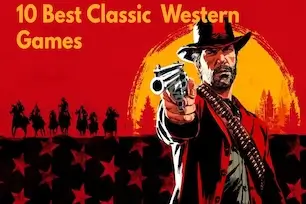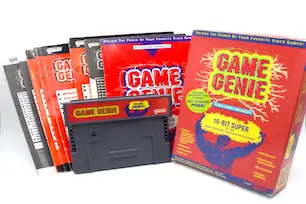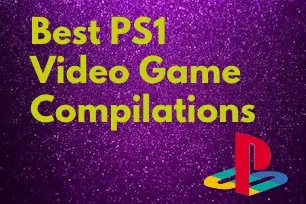The 1980s was a decade that dreamed big—sometimes bigger than reality could deliver. It promised flying cars, robot assistants, and stock market riches for all, yet mostly gave us a few “Rocky” sequels and a plasma globe from The Sharper Image.
Still, beyond the kitsch, the ‘80s was defined by its optimism, unforgettable music, and the birth of modern video gaming.
This was the golden age of the arcade, when the hum of machines and the clatter of quarters filled the air, and the rise of home consoles brought 8-bit adventures into living rooms around the world.
The Table of Contents
For those of us who grew up in this era, the 1980s wasn’t just a decade—it was our gaming generation. This article highlights the most iconic 1980s video games that shaped that generation.
Iconic 1980s Video Games That Defined a Generation
Pac-Man (1980 – Namco, Arcade)
There isn’t much to say about “Pac-Man” that hasn’t already been written about ad nauseam over the years. Still, this arcade machine will always earn a top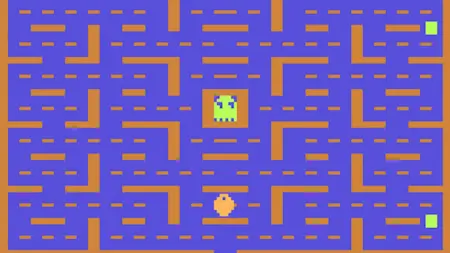 spot on any ’80s-video-game list.
spot on any ’80s-video-game list.
Not only for the iconic status of its protagonist, but because it was released in 1980 on the nose, kicking off an arcade revolution and setting the creative tone of video-game character development for generations to come.
- Fun fact: Japanese game designer Toru Iwatani didn’t set out to make a title that appealed to the target demo of arcade-dwelling adolescent boys.
- No, Iwatani and developer Namco wanted to welcome young girls into the gaming tent, so they created a brightly colored world populated by a cute hero and mostly harmless villains. It was all soft-lines and femininity—and boys everywhere ate it up.
Super Mario Bros. (1985 – Nintendo, NES)
Another obvious choice, but one that would be a crime to omit. “Super Mario Bros.,” released for the NES in 1985, is widely considered the most famous platformer of all time and remains one of the best.
It was that rare sequel that improved on its predecessor, 1983’s “Mario Bros.,” by adding a vibrant fantasy narrative where mustached Mario and his brother Luigi journey through the Mushroom Kingdom to rescue Princess Toadstool.
- When it debuted, arcades were fading and the home console market was struggling, with video games on the verge of collapse.
- Then along came an Italian plumber and his brother, revitalizing the industry and cementing Nintendo’s dominance.
- Need more proof of Mario’s cultural impact? He even inspired one of the most infamous Hollywood video game movies of all time.
Takeaway: Super Mario Bros. didn’t just set the standard for platformers—it saved the home console market and became the blueprint for modern game design.
Q*bert (1982 – Gottlieb, Arcade)
Surprisingly, this game’s quirky, long-nosed hero wasn’t the creation of a Japanese design team. Q*bert was entirely American-made, conceived by U.S. designers and published by Gottlieb, a Chicago-based company.
designers and published by Gottlieb, a Chicago-based company.
- Released in 1982, it became a defining title of the Golden Era of arcade gaming, thanks to its innovative 3D-like isometric graphics and unique gameplay.
- Bouncing the orange protagonist around a pyramid of cubes while avoiding enemies and obstacles.
- Q*bert was one of the most beloved joystick arcade machines of the 1980s and remains addictive even decades later.
- Its influence stretched beyond gaming—by the late 1990s and early 2000s, even a scratch DJ adopted the name as a tribute to the character’s enduring pop culture status.
Takeaway: Q*bert’s distinctive style, clever design, and lasting cultural footprint secured its place as one of the most memorable arcade games of the 1980s.
Pole Position (1982 – Namco, Arcade)
“Pole Position” was one of Namco’s most influential arcade titles and a landmark in racing game history. Released in 1982, this Formula One simulator may look modest by today’s standards, but it pioneered the blueprint for the modern racing genre.
- The game became wildly popular in U.S. arcades, and by 1983—after being licensed to Atari—it dominated the home gaming market as well.
- Gamers loved that it was based on a real Grand Prix circuit, complete with time trials and competitive races. Despite the era’s technological limits, it delivered a surprisingly immersive driving experience, enhanced in arcades by a steering wheel, gearshift, and pedals.
Pole Position Gameplay Video
 ▶
▶
Takeaway: Pole Position set the standard for racing games, blending real-world inspiration with innovative controls to create one of the most memorable arcade experiences of the 1980s.
Tron Deadly Discs (1982 – Mattel, Intellivision)
The feature film “Tron” was as much a product of the 1980s as the video game version “Tron” was a product of that film. In many ways, the decade and the title were made for each other.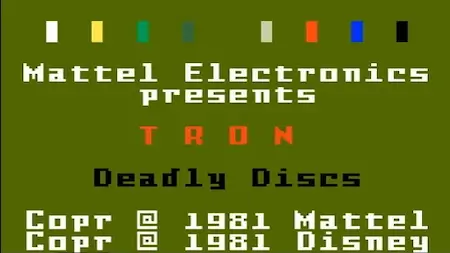
That said, both the 1982 movie and the game were moderate successes rather than critical darlings—remember, this is a list of games that defined the ’80s, not necessarily the best games of the era.
- The film’s story centered on a computer programmer who gets pulled into his own digital world, and the arcade adaptation mirrored that concept.
- One of its standout segments, the “light cycles” sequence, let players outmaneuver opponents while leaving glowing trails in their wake.
- While the potential for greatness was there, the game never quite matched the appeal of its most memorable feature—its striking translucent blue joystick.
Takeaway: Tron Deadly Discs may not have been a masterpiece, but its unique style, light cycle gameplay, and link to a cult sci-fi film earned it a lasting place in 1980s gaming history.
Arkanoid (1986 – Taito, Arcade/NES)
You can draw a direct line from today’s mobile puzzle games to the addictive gameplay of “Arkanoid.” Released by Taito in 1986, this title was an evolution of Atari’s classic “Breakout” series from the previous decade.
- The premise was deceptively simple: move a “paddle” (actually a spaceship) along the bottom of the screen, bounce a ball upward, and break colored tiles.
- Yet Arkanoid elevated this basic, Pong-like formula with a variety of power-ups, clever obstacles, layered visuals, and diverse level designs that kept players hooked for hours.
- Some point to “Tetris” as the most influential block-based game of the era, but many modern mobile titles borrow more from Arkanoid’s fast-paced, power-up-driven style than from its Soviet puzzle counterpart.
Takeaway: Arkanoid transformed a simple brick-breaking concept into a high-energy, power-up-packed experience that continues to influence puzzle and arcade-style games today.
Commando (1985 – Capcom, Arcade/NES)
Was “Commando” remarkable? Not exactly. Was it iconic? In its own way. Released by Capcom in 1985, this run-and-gun vertical scroller was one of those vintage video games that, while simple, laid important groundwork for future action titles like “Metal Slug” and “Contra.”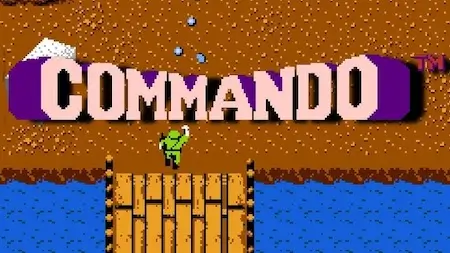
- Players took control of “Super Joe,” a lone soldier dropped into hostile territory to face endless waves of enemy troops.
- Armed with limitless ammo and grenades, players advanced up the screen, destroying anything in their path. The gameplay could be repetitive, but the nonstop action and satisfying grenade tosses kept arcade-goers coming back.
Fun fact: Despite sharing a name with the 1985 Arnold Schwarzenegger movie “Commando,” Capcom’s game was not based on the film. The two projects were developed independently and simply happened to release in the same year.
Takeaway: Commando may not have been groundbreaking, but its straightforward run-and-gun formula inspired a wave of arcade shooters that followed.
Dig Dug (1982 – Namco, Arcade/Atari)
The early 1980s arcade boom led to a wave of new machines vying to be the next “Pac-Man.” One of the quirkiest contenders was “Dig Dug,” released by Namco in 1982.
Players controlled the titular Dig Dug, a tunneling hero in white overalls, as he hunted underground foes—including tomato-like monsters and small dragons—by digging through dirt-filled levels.
- What set “Dig Dug” apart was its bizarre yet memorable attack method: instead of eating enemies, Dig Dug used an air pump to inflate them until they popped.
- The strange but satisfying mechanic, paired with colorful visuals and simple controls, made it a hit in arcades and at home.
- It was soon ported to nearly every major console of the time, including the Atari 2600 and Commodore 64.
My Two Cents: I remember playing this game on my dad’s DOS computer, staring at a black-and-green screen as a little boy. Even without the colorful arcade graphics, the gameplay was so engaging that I would lose track of time chasing down monsters underground.
Takeaway: Dig Dug’s oddball charm, unique gameplay, and widespread availability cemented it as one of the most memorable arcade titles of the 1980s.
Contra (1987 – Konami, Arcade/NES)
If you know what “up-up-down-down-left-right-left-right-A-B-start” means, you’re a card-carrying member of the 1980s gaming faithful. And really, how can you get more ’80s than naming a video game after one half of a political scandal that defined the decade?
This Konami classic had nothing to do with the rebel group that shared its name. Instead, “Contra” delivered fast-paced, side-scrolling shooter action with two big innovations for the time: two-player simultaneous co-op and a control scheme that let you aim in multiple directions while moving.
And of course, the not-so-secret Konami Code unlocked 30 lives—turning alien-blasting chaos into an all-night event.
- For me, Contra was more than just a game—it was a weekend tradition. Whenever my uncle brought his NES to family gatherings, we’d fire up Contra, sit
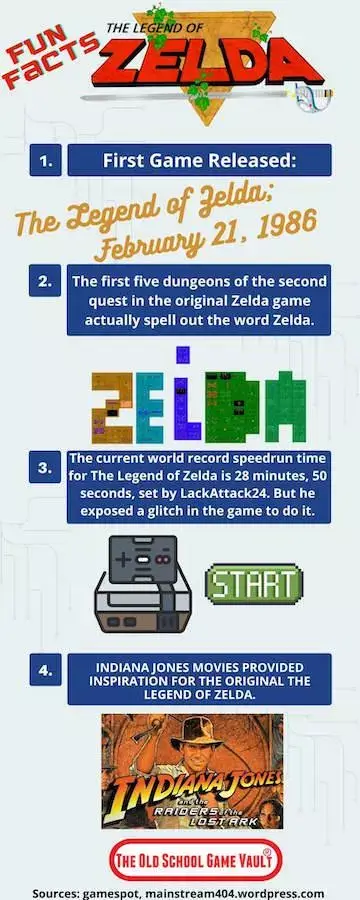 cross-legged on the carpet, and battle through levels together. It wasn’t just about beating the game—it was about laughter, teamwork, and the kind of memories that stick with you decades later.
cross-legged on the carpet, and battle through levels together. It wasn’t just about beating the game—it was about laughter, teamwork, and the kind of memories that stick with you decades later.
- You can read our NES Contra review.
Takeaway: Contra’s mix of co-op action, multi-directional shooting, and the legendary Konami Code made it one of the most beloved, and most replayed, NES games of the 1980s.
Here is some Awesome Two Player GamePlay of Contra
 ▶
▶
The Legend of Zelda (1986 – Nintendo, NES)
It’s hard to make a list of iconic 1980s video games without including “The Legend of Zelda.” Released in 1986, this 8-bit NES adventure kicked off one of the most celebrated video game franchises in history. Even today, in a world of billions of polygons, the original Zelda still offers incredible replayability.
The game was groundbreaking for its time, blending action, role-playing elements, and puzzle-solving into one cohesive experience. Its success paved the way for 17 sequels and spin-offs across Nintendo’s consoles, and as of 2016, the franchise has sold more than 75 million units.
- Want to read more about the history of Zelda? We’ve got you covered – read more here.
Fun fact: The name “Zelda” for the titular princess has nothing to do with the game’s story. Co-creator Shigeru Miyamoto named her after Zelda Fitzgerald, the wife of novelist F. Scott Fitzgerald, whom he described as “a famous and beautiful woman from all accounts.”
Donkey Kong (1981 – Nintendo, Arcade)
What can you say about this trailblazing platformer that hasn’t already been covered in countless articles, documentaries, and arcade retrospectives?
Released in 1981, “Donkey Kong” introduced players to Super Mario; then simply known as “Jumpman”, in his first appearance, as he leapt between platforms, dodged rolling barrels, and attempted to rescue Princess Pauline from the titular barrel-tossing gorilla.
Over the years, competitive Donkey Kong has developed a devoted cult following. In 2016, competitive gamer Wes Copeland set a nearly perfect score of 1,218,000 points, a feat widely regarded as one of the most impressive achievements in arcade gaming history.
- I remember playing Donkey Kong at our local Maid-Rite as a kid, standing on tiptoe just to reach the joystick. I’d spend my allowance one quarter at a time, trying to get past the second stage—usually failing, but loving every moment of it.
Takeaway: Donkey Kong didn’t just launch Mario’s career—it redefined the platforming genre and remains one of the most influential arcade games ever made.
The Retro Wrap Up:
This list represents just a small sample of the most iconic games of the 1980s—titles that helped define a generation of players and shaped the future of gaming. Anyone who grew up during this era will likely remember many of these vintage classics, whether they played them in bustling arcades or at home on their favorite console.
Even major gaming publications agree—The Guardian ranked titles like Pac-Man and Super Mario Bros among the greatest video games of the 1980s, underscoring just how deeply these games are woven into gaming history.
What about you? Are there any other 1980s games you think deserve a spot on this list? Share your favorites, and if you’re ready to part with your own collection, you can sell your video games to The Old School Game Vault for fast cash today.
Frequently Asked Questions:
What were the most popular 1980s arcade video games?
- Pac-Man, Donkey Kong, Galaga, and Space Invaders dominated arcades in the 1980s.
What are the best-known 1980s video games of all time?
- Titles like Super Mario Bros., Tetris, The Legend of Zelda, and Pac-Man are among the most famous.
How did 1980s video games shape the future of gaming?
- They introduced iconic genres, game mechanics, and characters that still influence modern games.
What consoles were popular in the 1980s?
- The Nintendo Entertainment System (NES), Atari 2600, Sega Master System, and Commodore 64 were key systems.
Which 1980s video games are still fun to play today?
- Games like Tetris, Super Mario Bros., and The Legend of Zelda remain enjoyable for modern players.
- I still play the Original Legend of Zelda every other year.




